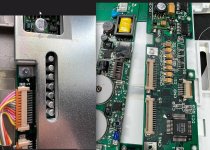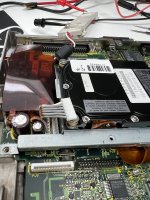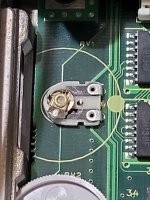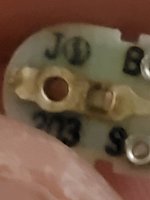RetroHospital
Experienced Member
Okay so here it is
On the left, still enclosed in the screen aluminium frame : the LCD screen board that has those freaking 3,3uF that you find in each screen of the era, that were all ultra leaky and crusty.
On the right, the fully recapped same board (out of the aluminium bezel for obvious reasons) + the inverter board, fully recapped as well
For reasons that I agree with I only recap inverter boards with proper electrolytics, not with tantalums - but that's just my opinion.
I only recap inverter boards with proper electrolytics, not with tantalums - but that's just my opinion.

Motherboard has been recapped in the same way
Now I "just" have to put all of this back they way it was and hope for the best

By the way, sometimes recapping is useless, here this unit would absolutely never worked again without FULL recapping.
Every single of the caps was long dead. Reminds me of a macintosh plus.
If I'm lucky and this ever boots again, I'll later try to "upgrade" the IDE HD with a compact flash, as it's likely to fail very soon.
On the left, still enclosed in the screen aluminium frame : the LCD screen board that has those freaking 3,3uF that you find in each screen of the era, that were all ultra leaky and crusty.
On the right, the fully recapped same board (out of the aluminium bezel for obvious reasons) + the inverter board, fully recapped as well
For reasons that I agree with

Motherboard has been recapped in the same way
Now I "just" have to put all of this back they way it was and hope for the best

By the way, sometimes recapping is useless, here this unit would absolutely never worked again without FULL recapping.
Every single of the caps was long dead. Reminds me of a macintosh plus.
If I'm lucky and this ever boots again, I'll later try to "upgrade" the IDE HD with a compact flash, as it's likely to fail very soon.



